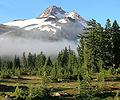Some mountain meadows in the U.S. Northwest are steadily disappearing as the effects of climate change have allowed trees to invade the ecosystemsin recent decades, a new study says. In an analysis of Jefferson
Park, a 330-acre subalpine meadow complex in the Oregon Cascades once covered with grasses, shrubs and wildflowers, researchers found that tree occupation increased from 8 percent in 1950 to 35 percent in 2007, a rapid shift they say reflects a wider trend in many areas of the U.S. West. According to scientists, rising temperatures and a reduction in snowpack duration were critical factors in the invasion of mountain hemlocks, saying the extended growing season significantly increased chances of the trees’ survival. “Once trees become fully established, they tend to persist, and seed banks of native grass species disappear fairly quickly,” said Harold Zald, of Oregon State University’s College of Forestry, the lead author of the study published in Landscape Ecology. “The meadows form an important part of forest biodiversity, and when they are gone, they may be gone forever.”
Click to enlarge
Oregon State University
A meadow at the base of Mount Jefferson.